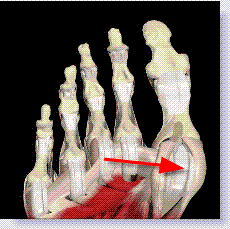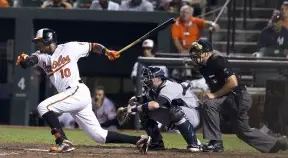turf toe
AUTHOR: Marc Mitnick DPM home --> turf toeWHAT IS TURF TOE
turf toe is a common athletic injury. It is seen at all levels of competition, even among professional athletes. Even though it is not considered a serious injury it can be very debilitating and take a long time to heal.
Basically in this condition the great toe is hyperextended (the big toe is excessively bent upwards) thus over stretching the tendon underneath the big toe usually at the level of first metatarsal-phalangeal joint (the joint where the big toe bends). In addition the capsular ligament (a ligament which wraps around a joint to maintain joint integrity) is also over stretched and it too becomes painful.
Below is a drawing of where the injury occurs. The drawing below shows the direction of the mechanism of injury as well as the ligament that is affected

|
Typically, turf toe is seen in athletes who do a lot of running and quick pivoting such as a running back in football or perhaps a soccer player. It is seen more on hard surfaces like artificial turf and that is actually how it got its name. This is compounded by the type of shoe that they are wearing which is typically a cleated shoe with a very flexible sole. The athlete will be running along, the cleats are “grabbing” the ground and keep the shoe planted to the ground for a fraction of a second longer than a non cleated shoe would. Because the shoe is temporarily “stuck” in the ground but the athletes keeps moving forward, this causes an excessive amount of dorsiflexion at the level of the first metatarsal-phalangeal joint. The fact that the athletic shoe is also very flexible in the forefoot further exacerbates the problem.
If the particular step by the athlete also involves pivoting this further aggravates the plantar structures (the soft tissue structures underneath the bone; in this case the tendon and capsular ligament), by grinding the soft tissue further into the hard surface. In some cases this can actually tear the capsular ligament.
Below is a picture of a baseball player hyper-extending his right forefoot.

|
Some athletes will remember the exact time the injury occurred. In other athletes it may be the result of the cumulative effect of playing a game and they do not really notice it until afterwards.
Typically, the patient will complain of pain and swelling in the affected area. There will also be limitation of motion of the great toe. The diagnosis itself is easy enough to make but an xray is helpful to make sure there is no fracture.
The sesamoid bones which lie a little bit further back should also be examined to rule out a fractured sesamoid.
This condition is classified according to MRI findings. X-rays are not really helpful in this situation as they do not show damage to ligaments and other soft tissue. An x-ray may be helpful, initially, to rule out a fracture particularly of one of the sesamoid bones.
Grade 1-irritation of the plantar plate. MRI reveals edema, mild sprain like findings to the plantar plate.
Grade 2-partial tear. MRI reveals a partial tear of the plantar plate structure.
Grade 3-complete tear. MRI reveals full thickness tear to plantar plate.
HOW DO YOU TREAT TURF TOE
Cessation of sports activity- Treatment consists of cessation of the sports activity usually for about three to four weeks in a young athlete, possibly longer in an older individual.
Physical therapy- can be very helpful in speeding up the recovery period.
Anti-inflammatory medication (short term basis) is very helpful. This will help reduce the pain to a manageable level.
Taping the big toe to limit the motion of the joint. A podiatrist, athletic trainer or physical therapist should be able to perform this.
Rigid shoe- The patient should wear a rigid shoe which will not allow the big toe to over extend. Many times a cushioned arch support is added for additional protection.
The problem with turf toe is that it can recur. If you are going to go back to your same sport, on the same surface, in the same athletic shoe, you are almost destined for a recurrence.
In my practice I generally try to get a patient into a better athletic shoe, (since I cannot change the sport, nor change the surface). In addition in cases where I feel there is a high propensity for recurrence I will often make a prescription orthotic with a Mortons extension which is a device added to the orthotic to not allow the big toe to overextend. Click here for more information on turf toe and orthotics.
In closing it should be noted that turf toe is not limited to the great toe; this condition can happen at the level of the metatarsal-phalangeal joint of the lesser toes as well, although, it is not as common.
REFERENCES
Want more information? CLICK HERE
Para traducir esta pagina, ve al boton de traduccion de Google en las esquina superior derecha de la pagina


Recent Articles
-
Vitamin D impact on health
Feb 06, 23 07:17 PM
Researchers are suggesting that the effectiveness of Vitamin D in fighting and preventing disease is predicated on a persons body mass index (BMI). The thinner the person the greater the positive impa… -
Foods to speed up healing
Feb 01, 23 02:41 PM
One of the best ways to help yourself heal faster after surgery is to eat well. Getting the proper nutrition will provide your body with the essentials it needs to promote healing. Here is a suggestio… -
Cancer and Type 2 Diabetes
Jan 25, 23 04:52 PM
An article revealing that older type 2 diabetics have a higher incidence of cancer then non-diabetics. It is suggested that cancer may surpass CVD as the number one cause of death in older diabetics. -
Does glucosamine or MSM reduce arthritis pain?
Jan 22, 23 01:41 PM
A good review of the possible benefits to taking glucosamine, chondroitin or MSM for arthritis. Always beware of the possible side effects of over the counter supplements. -
shin splints
Jan 18, 23 05:12 PM
A great review on the various causes of shin splints, along with treatment options. -
Whats new in skin cancer?
Jan 15, 23 08:32 PM
A presentation of newer skin protection combinations in an effort to better protect the skin from the hazards of sun exposure. -
Causes and risk factors of warts
Jan 14, 23 05:02 PM
A good review of the causes of warts and protective measures you can take to prevent developing them. -
Do chronic wounds need to be dressed daily?
Jan 11, 23 02:18 PM
Because of supply chain shortages as well as staffing shortages particularly during the pandemic, many institutions extended the time between dressing changes for chronic wounds. Is this really the be… -
Food choices that raise your risk of type 2 diabetes
Jan 08, 23 10:07 AM
A good review of how blood sugars can become elevated and the harm that can do. Certain food groups have a tendency to raise your blood sugars and should be avoided. -
Outcome stats from Scarf bunionectomy
Jan 03, 23 03:04 PM
The Journal of Foot and Ankle Surgery recently reported a meta analysis of outcomes in 1583 Scarf bunionectomies that met their inclusion criteria. Adverse events did not seem to be any better or wors…